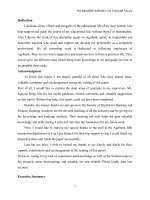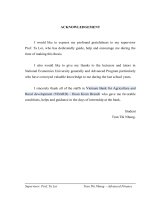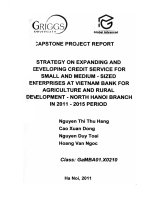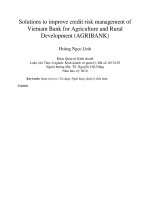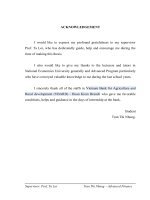Marketing mix solutions to develop Agribank cards at Vietnam Bank for Agriculture and Rural Development – Thanh Xuan branch
Bạn đang xem bản rút gọn của tài liệu. Xem và tải ngay bản đầy đủ của tài liệu tại đây (275.62 KB, 38 trang )
i
Acknowledgement
I owe a debt of gratitude to many people who helped me complete this thesis. I
would like to acknowledge the help of all. First of all I would like to express my
deepest acknowledgement to my supervisor, Professor Ngo Thuy Lan from National
Economics University of Foreign Languages Department, for her valuable advice
and recommendations.
I acknowledge Ms. Ha Viet Hoa, Head of Department of Marketing, Ms. Nguyen
Ngoc Anh, and Ms. Dinh Thi Thu Trang, Mr. Nguyen Huy Hoang, Mr Nguyen Hai
Tuan, Mr Trinh Thanh Dong, staff from Thanh Xuan branch of Agribank for their
support with statistical techniques and data analysis.
I am greatly indebted to Mrs. Nguyen Thi Nhu Van, Chief accountant, who
introduced me to Marketing Department and continuously encouraged me during
internship time at Thanh Xuan branch. I would particularly like to thank all staff
from Marketing Department and all members of Thanh Xuan branch of Agribank
for their help, support and providing related information, data
I would like to thank Foreign Languages Department of National Economics
University, Marketing Department of Thanh Xuan branch of Agribank which
supported me in completing my thesis.
In the process of data collection for this research, many people contributed to the
task and I am particularly grateful for their contributions.
Finally, to my family and my friends, I wish to extend my loving thanks for their
encouragement. My greatest debt of gratitude is to my parents who were supporting
me during my study in University.
ii
Abstract
In the globalization context, trade activities grow in both quantities and quality. It
is required a new safe, fast and effective payment method. In addition, this century
witnesses a lot of successes in scientific and technical progress, especially success
in advanced information technology.
Nowadays, bankcards are used more and more popularly in societies. Bankcards
have features of a modern and perfect payment method:
To cardholders: Cardholders like the convenience of bankcards which can give
them the safety, fastness and effectiveness…in payment activities.
To banks: Bankcards’ operation is increasingly playing an important role in
banking business. The operation also helps reduce paperwork in banks dramatically
because transactions are carried out through computers and electronic systems.
To merchants: Merchants discovered that bankcard customers were most likely to
make a purchase and they bought more with the cards than with cash. Handling the
cards was also much safer than handling checks for which payment was not
guaranteed.
To societies: Bankcards’ transactions help reduce the cash pressure and it is a
progress to a “non-cash society”.
Owing to these advantages, bankcards gradually become a popular payment
method in developed countries as well as all over the world.
Bankcards were used in Vietnam since 1990s and they have really developed in
Vietnam market in recent years. Issuing and acquiring cards’ business made
significant achievement and profit for Vietnam market and commercial banks. To
Vietnam Bank for Agriculture and Rural Development, the bank has just joined
bankcard’s market for about six years, however, it has gained huge successes.
However, Thanh Xuan branch which was established for more than two years still
copes with many difficulties and challenges.
After internship time at Services and Marketing Department of Thanh Xuan
branch, I decided to choose topic: “Marketing mix solutions to develop
iii
Agribank cards at Vietnam Bank for Agriculture and Rural Development –
Thanh Xuan branch” for my report.
My report is divided into three chapters:
Chapter I: Overview of bankcard
Chapter II: The role of marketing activities to bankcard and actual state of
Agribank cards
Chapter III: Solutions to develop Agribank cards at Agribank Thanh Xuan
iv
Glossary of Terms and Abbreviations
Agribank Vietnam Bank for Agriculture and Rural Development
ABIC Agriculture Bank Insurance Joint – Stock Corporation
AMEX American Express
ATM Automatic Teller Machine
BIDV Bank for Investment and Development of Vietnam
EDC Electronic Data Capture
HSBC The Hongkong and Shanghai Banking Corporation
ICO International Card Organization
JCB Japan Credit Bureau
PG Bank Petrolimex Group Joint-stock Commercial Bank
PIN Personal Identity Number
POS Point of Sale
SBV The State Bank of Vietnam
SMS Short Message Services
SWIFT Society for Worldwide Interbank Financial Telecommunication
VCA Vietnam Card Association
VIB Vietnam International Bank
WSBA Western States Bankcard Association
Table of Contents
ACKNOWLEDGEMENT..........................................................................................i
v
ABSTRACT..............................................................................................................ii
GLOSSARY OF TERMS AND ABBREVIATIONS............................................... iv
TABLE OF CONTENTS...........................................................................................v
LIST OF TABLES AND FIGURES........................................................................vii
CHAPTER I: OVERVIEW OF BANKCARD ................................................................................. 1
1.1. General introduction about bankcard ....................................................................................................... 1
1.1.1. History of bankcard .................................................................................................................................................... 1
In Vietnam, the first card was accepted in 1990. It was the starting point for card’s products and
services in Vietnam. Nowadays, bankcard presents all over the world in diversified forms to meet
every demand of cardholders. Banks and financial institutions always try to improve bankcard to
reach a friendly and convenient payment method for customers. ...................................................... 2
1.1.2. Concept and classification ........................................................................................................................................ 2
Figure 1 - Types of bankcards...........................................................................................................................3
1.2. Cards’ activities in commercial banks ....................................................................................................... 5
1.2.1. Entities join card activities .......................................................................................................................................... 5
Figure 2 - Participants in bankcard transactions.............................................................................................5
1.2.2. Transaction process ................................................................................................................................................... 6
Figure 3 - Procedure of issuing bankcard.........................................................................................................7
Figure 4 - Procedure of acquiring cards...........................................................................................................8
CHAPTER II. THE ROLE OF MARKETING ACTIVITIES ........................................................... 9
TO BANKCARD AND ACTUAL STATE OF AGRIBANK CARDS ........................................... 9
2.1. Introduction of Vietnam Bank for Agriculture and Rural Development (Agribank) - Thanh Xuan
branch ................................................................................................................................................................. 9
2.1.1. Foundation and development of Agribank Thanh Xuan ............................................................................................ 9
Figure 5 – Education of staff...........................................................................................................................10
2.1.2. Organization structure .............................................................................................................................................. 10
Figure 6 - Organization Chart.........................................................................................................................11
2.1.3. Products and services .............................................................................................................................................. 11
2.2. Marketing activities at Agribank Thanh Xuan ....................................................................................... 12
2.2.1. Organization of Services and Marketing Department ............................................................................................. 12
Figure 7 - Services and Marketing Department ..........................................................................................12
2.2.2. Current marketing activities ..................................................................................................................................... 13
Table 1 - Total profit of services (VND million).............................................................................................14
2.2.3. The role of marketing to Agribank cards. ................................................................................................................. 14
2.3. Bankcard activities in the branch ............................................................................................................. 15
2.3.1. Introduction of Agibank cards .................................................................................................................................. 15
vi
Figure 8 - Types of Agribank Card.................................................................................................................16
2.3.2. Actual state of Agribank card in the branch ............................................................................................................. 17
2.3.2.1. Some results of development Agribank card ........................................................... 17
Table 2 - Result of issuing cards......................................................................................................................18
Table 3 - Devices of acquiring card of Agribank............................................................................................19
Diagram - Quantity of ATM, EDC..................................................................................................................20
2.3.2.2. Existing problems and difficulties. ......................................................................... 21
CHAPTER III. ................................................................................................................................. 23
SOLUTIONS TO DEVELOP AGRIBANK CARDS ........................................................... 23
AT AGRIBANK THANH XUAN .................................................................................................. 23
3.1. Advantages and disadvantages in developing bankcards ....................................................................... 23
3.1.1. Advantages 23
3.1.2. Disadvantages ......................................................................................................................................................... 23
3.2. Marketing mix solutions to develop Agribank card ................................................................................ 24
3.2.1. Study and set the target market ............................................................................................................................... 24
3.2.2. Marketing mix solutions to develop Agribank cards ................................................................................................ 26
3.2.2.1. Product policies ...................................................................................................... 26
3.2.2.2. Price policies ........................................................................................................... 28
3.2.2.3. Promotion policies ................................................................................................. 28
3.2.2.4. Place policies .......................................................................................................... 29
CONCLUSION ............................................................................................................................... 30
CONCLUSION 30
Bibliography
List of Tables and Figures
vii
Figure 1 - Types of bankcards
Figure 2 - Participants in bankcard transactions
Figure 3 - Procedure of issuing bankcard
Figure 4 - Procedure of acquiring cards
Figure 5 – Education of staff
Figure 6 - Organization Chart
Figure 7 - Services and Marketing Department
Table 1 - Total profit of services (VND million)
Figure 8 - Types of Agribank Card
Table 2 - Result of issuing cards
Table 3 - Devices of acquiring card of Agribank
Diagram - Quantity of ATM, EDC
1
CHAPTER I: OVERVIEW OF BANKCARD
1.1. General introduction about bankcard
1.1.1. History of bankcard
Bankcard history began when individual retail merchants extended credit to their
customers, allowing them to charge purchases to an account held by the merchant.
In 1730, Christopher Thompson, a furniture merchant, created the first
advertisement for credit by offering furniture that could be paid off weekly. However,
1950 marked the real beginning of the credit card most of us are familiar with today.
Diner’s Club, Inc. introduced the first credit card that could be used at a variety of
stores and businesses. Advantages of this card immediately took notice of many
people.
In 1960, Bank of American introduced its own bankcard, the BankAmericard. In
1966, fourteen United States banks formed Interbank, a new association with the
ability to exchange information on credit card transactions. The following year, 1967,
four California banks changed their named from the California Bankcard Association
to the Western States Bankcard Association (WSBA). The new WSBA licensed
Interbank to use the MasterCharge name and logo. In the late 1960s, numerous
financial institutions became MasterCharge (Interbank) members to compete with
BankAmericard. Eventually, financial institutions interested in issuing cards in the
U.S. became members of either BankAmericard or MasterCharge. In 1977,
BankAmericard became Visa USA/ Visa International. In 1979, MasterCharge
changed its name to MasterCard to reflect its expanded services. At the present time,
the leaders in the bankcard systems are Visa, Master Card, Amex and JCB.
Payment by bankcard quickly becomes popularity in other countries. In 1960, the
first plastic card was used in Japan marked the beginning of bankcard in Asia. The
first plastic card of Barcaly Bank issued in 1966 also highlighted a new period of
development of bankcard in Europe.
2
In Vietnam, the first card was accepted in 1990. It was the starting point for card’s
products and services in Vietnam. Nowadays, bankcard presents all over the world in
diversified forms to meet every demand of cardholders. Banks and financial
institutions always try to improve bankcard to reach a friendly and convenient
payment method for customers.
1.1.2. Concept and classification
Everyday millions of people all around the globe are using bankcards for making
credit card payments for their purchases. However, the fact that not every cardholders
know concept of a bankcard
* Concept:
In simple terms: A bankcard can be described as a plastic card issued by a bank or a
financial institution which the cardholder can gain access to the financial resources of
the bank as a line of credit.
* Classification:
There are many types of cards that can be used as alternative forms of payment.
Financial institutions issue some and bank issues others. Many allow the balance to
be paid in full each month. Some take the payment directly from the cardholder’s
bank account while others require that the cardholder send payment to the issuer.
Herein, I list some popular ways to divide bankcards.
3
Figure 1 - Types of bankcards
* Payment method:
- Debit card: A plastic card used to initiate a debit transaction. In general, these
transactions are used primarily to purchase goods and services and to obtain cash, for
which the cardholder's asset account is debited by the issuer
Debit card consist of two basic types:
+ On-line debit card: An online-debit card deducts funds from the bank account
immediately, as soon as the card is used. There is no delay for processing the
transaction
+ Off-line debit card: An off-line debit card does not deduct funds from the
checking account immediately. Transactions are processed like a regular credit card
and the funds are not deducted for 24-72 hours.
Debit card
Payment
method
Area of
Using card
International card
Technical
Feature
Issuer
Credit card
Magnetic stripe card
Smart card
Bankcards
Travel and
Entertainment cards
Domestic card
Cash card
Cards
4
Most issuers of debit cards are moving to this type of card rather than on-line debit
card
- Credit card: A plastic card bearing an account number assigned to a cardholder
with a credit limit that can be used to purchase goods and services and to obtain cash
disbursements on credit, for which a cardholder is subsequently billed by an issuer for
repayment of the credit extended at once or on an installment
basis
- Cash card: Cash cards are similar to pre-paid phone cards. The card is worth a
certain amount of cash and the retailer must use a special cash card reader to debit the
card. Each purchase is deducted from the value left on the card until the pre-paid
amount is spent. These cards are just like cash – if lost or stolen, there is no way to
retrieve the money on the card.
* Technical feature:
- Magnetic stripe card: The magnetic stripe on the bankcard plastic was encoded;
this stripe contains information pertinent to the cardholder account
- Smart card: The smart card, also known as the chip card, contains a computer
chip embedded in the plastic. When read by a special terminal designed to interact
with the embedded chip, the card can perform a number of functions or access data
stored in the chip. These cards can be used as cash cards or as credit cards with a
preset credit limit.
* Issuer:
- Bankcards: Banks, financial institutions around the world distribute cards. A
cardholder borrows money against a credit line and repays those funds with interest if
the balance is carried over from month to month.
These cards are used all around the world, such as: Visa USA, MasterCard…
- Travel and entertainment cards: travel and entertainment corporations distribute
their own cards so they are not considered bankcards since they are not issued by a
financial institution. These cards are widely used by business for their travel and
entertainment expenses, such as American Express (AMEX), Dinners Club…
* Area of using card:
5
- Domestic card: Card is used in domestic only with legal tender of that nation.
- International card: Card is used around the world, used strong currencies in
transactions.
1.2. Cards’ activities in commercial banks
1.2.1. Entities join card activities
Figure 2 - Participants in bankcard transactions
The figure shows 5 entities joining a bankcard transaction.
* International card organizations: (ICO)
For example MasterCard or Visa International/Visa USA, they are worldwide
payment service organization composed of member institutions. They set and enforce
rules and regulations governing operational procedures, interchange procedures, and
graphic design approval of their cards…
These organizations do not have a direct relationship with cardholders and
merchants.
Any bank has international card must be a member of an ICO
* The issuing members: The cardholder’s financial institution (usually called the
issuing member or issuer) is a licensed member of an ICO. The issuer directly issues
the card to the approved cardholder. The issuer may also benefit from services of a
third party processor and/or association in processing information and payments.
* The acquiring members:
The issuing
members
International
card
organization
The acquiring
members
Merchant
Cardholders
6
The acquiring members, or acquirer, solicits screens and accepts merchants into its
bankcard program. The acquirer is also a member of an ICO, and holds a written
agreement with the merchant to:
- accept the merchant sales drafts
- provide the merchant with credit card authorization terminals, instructions, and
contracted support services
- handle and process the credit card transactions
The acquirer usually charges the merchant a merchant discount for handling the
transactions. The acquirer is licensed by an ICO agrees to follow the operating rules
and regulations of the two associations.
In fact, many banks and financial institutions are both issuers and acquirers. As
issuers, they maintain the cardholder relationship. As acquirers, they maintain the
merchant relationship.
* Cardholders:
The customer to whom a card has been issued or the individual authorized to use
the card .
The cardholder uses the bankcard either to purchase goods and services from a
merchant, or to obtain a cash advance from a member for which the cardholder
receives a monthly bill from the issuer.
* Merchants:
The merchant can be virtually any company which meets the qualification
standards of an ICO and an acquirer.
The ICO usually requires that the merchant must be financially responsible and has
a good repute. The merchant has a written agreement with the acquirer to accept the
bankcards as a payment and to abide by the terms of the agreement.
1.2.2. Transaction process
* Issuing:
7
Figure 3 - Procedure of issuing bankcard
+ Customers
- Customers fulfill and sign on the application and credit card agreement
- Required documents: photograph 3x4 or 4x6, Copies of Identity card, copies of
passport, visa or residence permit…
- Types of guarantee for card payment.
+ Issuing banks
- Checking customer’s application, then decide to approve or not
- Approving
- Sending their requests of opening a new card to the card centre
- Receiving new card and personal identity number (PIN) from the card centre
- Handing new card and PIN over customers
- Guiding the customer to use card
+ The Card centre
- In responsibility of receiving information of customers from issuing banks
- Produce a new card
- Deliver cards to issuing banks
Customer
Application
Approval
Guide of using
Handing card
and PIN over
Receiving new
card and
PIN from centre
Registration of
issuing

